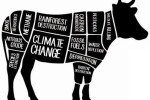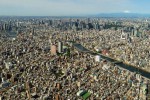Food and Hunger/Agriculture
Jun 19th, 2020 |
By admin

By Geoffrey Holland, guest writer for Transition Earth. Humans have been a distinct species for at least 200,000 years. For most of those years, we were stone age nomads. Humans are omnivores, which mean we are able and willing to eat almost anything. During the Neolithic era, generally speaking, men hunted animals to eat, while
[continue reading…]
Posted in Food and Hunger/Agriculture |
1 Comment »
Tags: agriculture, human behavior, industrial agriculture, plant-based diets, Population
May 3rd, 2020 |
By admin
![[photo: https://en.wikipedia.org/wiki/Vertical_farming]](http://populationgrowth.org/wp-content/uploads/2020/05/vertical-farming-150x100.jpg)
By Geoffrey Holland, guest writer for Transition Earth. All humans require nourishment. No exceptions. The future of food may reside in multi-story urban structures, built out with hi-tech hydroponic or aeroponic crop growing systems. Another name for this is vertical farming. There’s a lot to like about vertical farms. They require about 90% less water
[continue reading…]
Posted in Featured, Food and Hunger/Agriculture |
No Comments »
Tags: Climate Change, Commission on the Human Future, food security, urban farming, vertical farming
Mar 20th, 2020 |
By admin
![[Photo: FAO]](http://populationgrowth.org/wp-content/uploads/2020/03/locusts-photo-150x100.jpg)
By Joshua Mironda, youth writer for Transition Earth. You may have heard that plagues of locusts have descended upon East Africa. This is not a biblical story, but real life, with serious implications for people and nature. Here in Uganda, at the beginning of February, desert locusts invaded the country through its Amudat district and
[continue reading…]
Posted in Food and Hunger/Agriculture |
No Comments »
Tags: agriculture, FAO, food security, locusts, Uganda
Dec 5th, 2019 |
By admin
![Sustainable coffee cooperative worker, near Bwindi Impenetrable National Park, Uganda [photo: Suzanne York]](http://populationgrowth.org/wp-content/uploads/2019/12/woman-Bwindi-coffee-coop-picker2-150x100.jpg)
By Julian Cribb FRSA FTSE*, guest writer. The fate of human civilization in the mid-21st Century turns critically on food. Success in overcoming the intersecting challenges of climate and resource scarcity will bring peace, plenty and a chance to repair the Planet. Failure will bring war. Food or War (Cambridge University Press 2019) presents compelling evidence
[continue reading…]
Posted in Food and Hunger/Agriculture |
No Comments »
Tags: Climate Change, Food or War, food security, global food system, regenerative agriculture, soil
May 20th, 2018 |
By admin
![Young Masai herder. [Photo: Andreas Lederer, Creative Commons Attribution 2.0 Generic license.]](http://populationgrowth.org/wp-content/uploads/2018/05/Young_Masai_herder-150x100.jpg)
By Karen Gaia Pitts, Transition Earth. Cattle are of critical importance to the Maasai people of East Africa and are the primary source of income. The Maasai rely on their land and above all their cattle for their livelihoods, and do so while facing many challenges. The Maasai Harmonial Development and Sustainability (MHDS) project is a community-based organization
[continue reading…]
Posted in Food and Hunger/Agriculture |
No Comments »
Tags: child marriage, livelihoods, Maasai, Maasai Harmonial Development and Sustainability, sustainability
Jan 5th, 2017 |
By admin

By Suzanne York. We live in an increasingly urbanized world. The growth of megacities – urban areas with a population of over 10 million – is a reflection of the rapid pace of urbanization in countries across the world. In 1990, there were 10 megacities across the globe. By 2030, the number is expected to
[continue reading…]
Posted in Food and Hunger/Agriculture |
No Comments »
Tags: food security, megacities, Migration, Population Growth, urbanization
Oct 20th, 2016 |
By admin
![[photo: FAO]](http://populationgrowth.org/wp-content/uploads/2016/10/argriculture-climate-change-drought-flood-disaster_crop1448546959694.jpg_1718483346-150x100.jpg)
By Suzanne York. Amazingly, but perhaps not surprisingly, climate change has been barely mentioned in the U.S. presidential elections. This, despite the fact that 2016 is likely to be the hottest year on record. Fortunately, the leaders of other countries seem to have a better handle on it. A landmark international climate agreement was
[continue reading…]
Posted in Food and Hunger/Agriculture |
No Comments »
Tags: agriculture, agroecology, Climate Change, FAO, poverty, Women's empowerment
Sep 4th, 2014 |
By admin
![Smallholder farmer in East Africa [photo credit: Neil Palmer/CIAT]](http://populationgrowth.org/wp-content/uploads/2014/09/Smallholder-farmer-in-East-Africa-672x445-150x100.jpg)
By Suzanne York, www.howmany.org Africa is a rich continent, where the land and its people have been plundered for centuries. Despite pockets of economic growth and improved living standards, most news from here is of conflict, poverty, environmental degradation and corruption. And it is growing. There are currently more than 1 billion people in Africa.
[continue reading…]
Posted in Food and Hunger/Agriculture |
No Comments »
Tags: food insecurity, food security, genetic engineering, traditional crops, women's rights
May 29th, 2014 |
By admin
![[photo credit: www.community.businessfightspoverty.org]](http://populationgrowth.org/wp-content/uploads/2014/05/images1-150x100.jpeg)
By Suzanne York, www.howmany.org. Carbon footprint size is often talked about, but what about agriculture’s footprint? Farming of crops and livestock uses more than 38 percent of the planet’s ice-free land. Humans have cleared land that amounts to nearly the size of South America to grow crops and to raise livestock, cleared an area almost
[continue reading…]
Posted in Food and Hunger/Agriculture |
No Comments »
Tags: agroecology, industrial agriculture, Population Growth, small farmers
Apr 9th, 2014 |
By admin
![[image credit: ciat.cgiar.org/]](http://populationgrowth.org/wp-content/uploads/2014/04/Land-Grabbing-CIAT-150x100.jpeg)
By Suzanne York, www.howmany.org The president of the World Bank, Jim Yong Kim, warned that battles over water and food will erupt within the next five to ten years as a result of climate change. As he was talking of the risks of climate change, the UN announced that food prices had risen to their
[continue reading…]
Posted in Food and Hunger/Agriculture |
2 comments
Tags: Climate Change, corporations, food security, land rights, Oakland Institute, Population Growth, World Bank


![[photo: https://en.wikipedia.org/wiki/Vertical_farming]](http://populationgrowth.org/wp-content/uploads/2020/05/vertical-farming-150x100.jpg)
![[Photo: FAO]](http://populationgrowth.org/wp-content/uploads/2020/03/locusts-photo-150x100.jpg)
![Sustainable coffee cooperative worker, near Bwindi Impenetrable National Park, Uganda [photo: Suzanne York]](http://populationgrowth.org/wp-content/uploads/2019/12/woman-Bwindi-coffee-coop-picker2-150x100.jpg)
![Young Masai herder. [Photo: Andreas Lederer, Creative Commons Attribution 2.0 Generic license.]](http://populationgrowth.org/wp-content/uploads/2018/05/Young_Masai_herder-150x100.jpg)

![[photo: FAO]](http://populationgrowth.org/wp-content/uploads/2016/10/argriculture-climate-change-drought-flood-disaster_crop1448546959694.jpg_1718483346-150x100.jpg)
![Smallholder farmer in East Africa [photo credit: Neil Palmer/CIAT]](http://populationgrowth.org/wp-content/uploads/2014/09/Smallholder-farmer-in-East-Africa-672x445-150x100.jpg)
![[photo credit: www.community.businessfightspoverty.org]](http://populationgrowth.org/wp-content/uploads/2014/05/images1-150x100.jpeg)
![[image credit: ciat.cgiar.org/]](http://populationgrowth.org/wp-content/uploads/2014/04/Land-Grabbing-CIAT-150x100.jpeg)